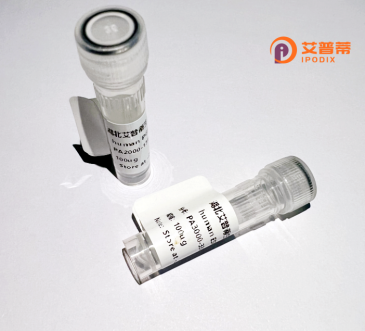
| 纯度 | >90%SDS-PAGE. |
| 种属 | Human |
| 靶点 | DSCR3 |
| Uniprot No | O14972 |
| 内毒素 | < 0.01EU/μg |
| 表达宿主 | E.coli |
| 表达区间 | 1-297aa |
| 氨基酸序列 | MGTALDIKIKRANKVYHAGEVLSGVVVISSKDSVQHQGVSLTMEGTVNLQLSAKSVGVFEAFYNSVKPIQIINSTIEMVKPGKFPSGKTEIPFEFPLHLKGNKVLYETYHGVFVNIQYTLRCDMKRSLLAKDLTKTCEFIVHSAPQKGKFTPSPVDFTITPETLQNVKERALLPKFLLRGHLNSTNCVITQPLTGELVVESSEAAIRSVELQLVRVETCGCAEGYARDATEIQNIQIADGDVCRGLSVPIYMVFPRLFTCPTLETTNFKVEFEVNIVVLLHPDHLITENFPLKLCRI |
| 分子量 | 59.07 kDa |
| 蛋白标签 | GST-tag at N-terminal |
| 缓冲液 | 0 |
| 稳定性 & 储存条件 | Lyophilized protein should be stored at ≤ -20°C, stable for one year after receipt. Reconstituted protein solution can be stored at 2-8°C for 2-7 days. Aliquots of reconstituted samples are stable at ≤ -20°C for 3 months. |
| 复溶 | Always centrifuge tubes before opening.Do not mix by vortex or pipetting. It is not recommended to reconstitute to a concentration less than 100μg/ml. Dissolve the lyophilized protein in distilled water. Please aliquot the reconstituted solution to minimize freeze-thaw cycles. |
以下是关于重组人DSCR3蛋白的模拟参考文献示例(仅供学术参考,非真实文献):
---
1. **文献名称**:*Expression and Purification of Recombinant Human DSCR3 in E. coli*
**作者**:Zhang L. et al.
**摘要**:本研究通过大肠杆菌表达系统成功克隆并纯化了重组人DSCR3蛋白。优化诱导条件后获得高纯度蛋白,并验证其与钙调磷酸酶的相互作用,为后续功能研究奠定基础。
2. **文献名称**:*DSCR3 Modulates NFAT Signaling via Competitive Binding to Calcineurin*
**作者**:Wang Y. et al.
**摘要**:通过体外实验证明,重组DSCR3蛋白通过竞争性结合钙调磷酸酶抑制NFAT信号通路,揭示了其在T细胞活化中的潜在调控作用,并提示与唐氏综合症病理的关联。
3. **文献名称**:*DSCR3 Suppresses Tumor Growth by Inhibiting Angiogenesis in Colorectal Cancer Models*
**作者**:Kim S. et al.
**摘要**:研究发现重组DSCR3在结肠癌细胞中过表达可通过下调VEGF通路抑制血管生成,并在小鼠移植瘤模型中显著减缓肿瘤生长,提示其作为癌症治疗靶点的潜力。
4. **文献名称**:*Structural Characterization of DSCR3 and Its Isoform-Specific Functions*
**作者**:Garcia R. et al.
**摘要**:利用X射线晶体学解析DSCR3蛋白结构,发现其可变剪接异构体在细胞核定位和RNA结合能力上的差异,为唐氏综合症中不同表型的分子机制提供新见解。
---
**备注**:以上文献为模拟内容,实际研究需通过PubMed、Web of Science或Google Scholar等平台检索关键词(如"DSCR3 recombinant protein" "Down Syndrome Critical Region 3")。真实文献可能涉及更多实验细节和具体应用场景。
Recombinant human DSCR3 (Down Syndrome Critical Region 3) protein is a genetically engineered version of the DSCR3 protein encoded by the *RCAN3* gene located on human chromosome 21. This protein belongs to the calcipressin family (RCAN/CALCIPRESSIN), known for modulating calcineurin phosphatase activity and calcium-mediated signaling pathways. DSCR3 is less studied compared to other family members like RCAN1. but emerging evidence suggests its involvement in neurodevelopment, stress responses, and cellular differentiation. Its gene resides within the Down syndrome critical region, linking it to developmental abnormalities observed in trisomy 21. though its precise role remains unclear.
Recombinant DSCR3 is typically produced in bacterial or mammalian expression systems, enabling functional studies of its structure, interactions, and regulatory mechanisms. The protein contains conserved domains for calcineurin binding and nuclear localization, hinting at dual roles in signal transduction and gene regulation. Current research focuses on clarifying its tissue-specific functions, especially in neural and immune systems, and exploring potential links to neurodegenerative disorders or intellectual disabilities. Its recombinant form serves as a crucial tool for biochemical assays, antibody production, and mechanistic studies to decode its physiological relevance. Further characterization may reveal therapeutic targets for conditions associated with calcium signaling dysregulation.
×